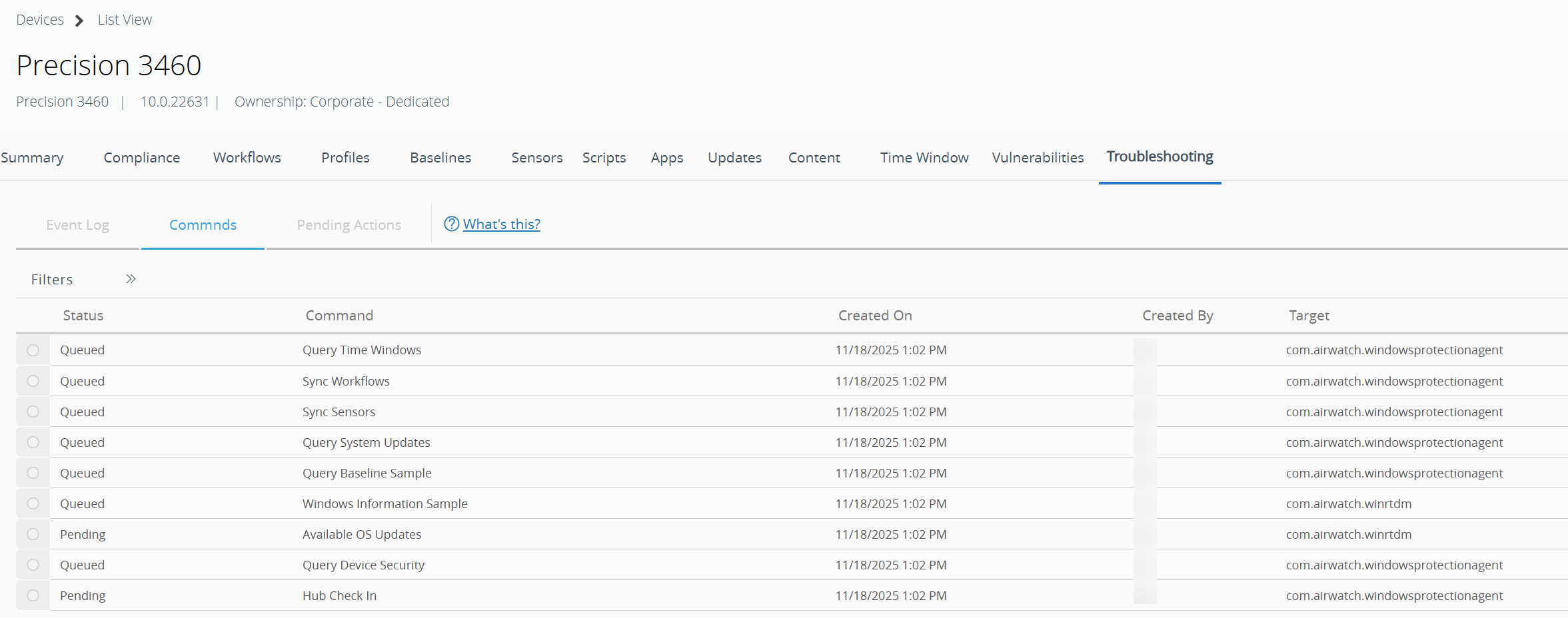Troubleshooting Workspace ONE Windows Devices
Overview
This guide provides information regarding steps that may be used to troubleshoot numerous Workspace ONE UEM Windows device issues.
The materials within this guide focus on general means for addressing overall Windows issues and should serve as a starting point. Numerous references have been provided to help you address specific issues.
The contents of this guide are focused on these areas:
- Windows device communications
- Windows settings
- Logging
- Validation and troubleshooting
- Common Windows device issues
- Additional resources
Windows lifecycle
This document covers general Windows troubleshooting. To address issues during specific stages of the Windows lifecycle, each of the following resources provides detailed information regarding processes, decision points, and validation/troubleshooting:
Workspace ONE Windows device communications
When communications between Workspace ONE UEM and Windows devices are interrupted, issues such as configurations not applying correctly, unavailability of new applications, and unexpected policy results may occur. As such, understanding the flow of communication and dependencies may help pinpoint the source of an issue.
Intelligent Hub/AWCM and OMA-DM/WNS communications explained
Secured real-time communication between Workspace ONE UEM and Windows devices can occur via two management systems:
- Omnissa Workspace ONE Intelligent Hub
- Communicates via AirWatch Cloud Messaging (AWCM)
- Required for Windows Server devices; recommended for Windows Desktop devices
- Microsoft OMA-DM (Open Mobile Alliance Device Management)
- Communicates via Windows Notification Services (WNS)
- Applicable to only Windows Desktop devices, not Windows Server
Intelligent Hub/AWCM
Intelligent Hub interfaces with AirWatch Cloud Messaging which then provides the communications interface between many Workspace ONE services as shown in the diagram below:
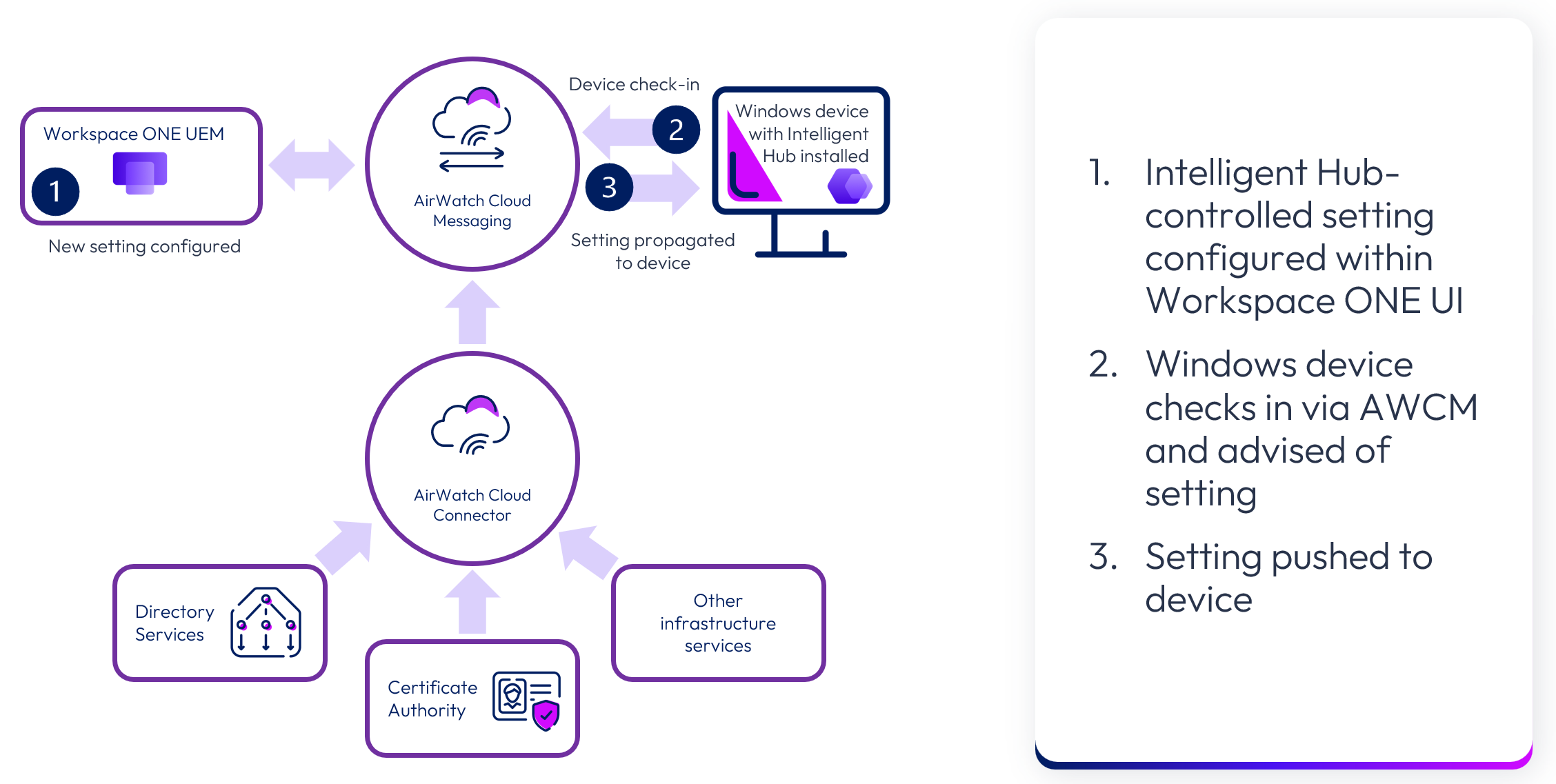
Figure 1: AirWatch Cloud Messaging (AWCM) provides centralized, secure communications
OMA-DM/WNS
OMA-DM uses Windows Notification Services (WNS), sometimes called Windows Push Notification Services, for communication between Workspace ONE UEM and Windows Desktop devices. Because OMA-DM is an open standard, any device management vendor can enroll and control Windows Desktop devices. However, this functionality is limited to one vendor connection at a time. When transitioning management vendors that rely on OMA-DM, it is necessary to unenroll from the existing system before enrolling the device into the new management system.
OMA-DM sends various commands in Synchronization Markup Language (SyncML) for action on Windows devices. While most of the commands are applicable to registry keys, some may apply to files and permissions.
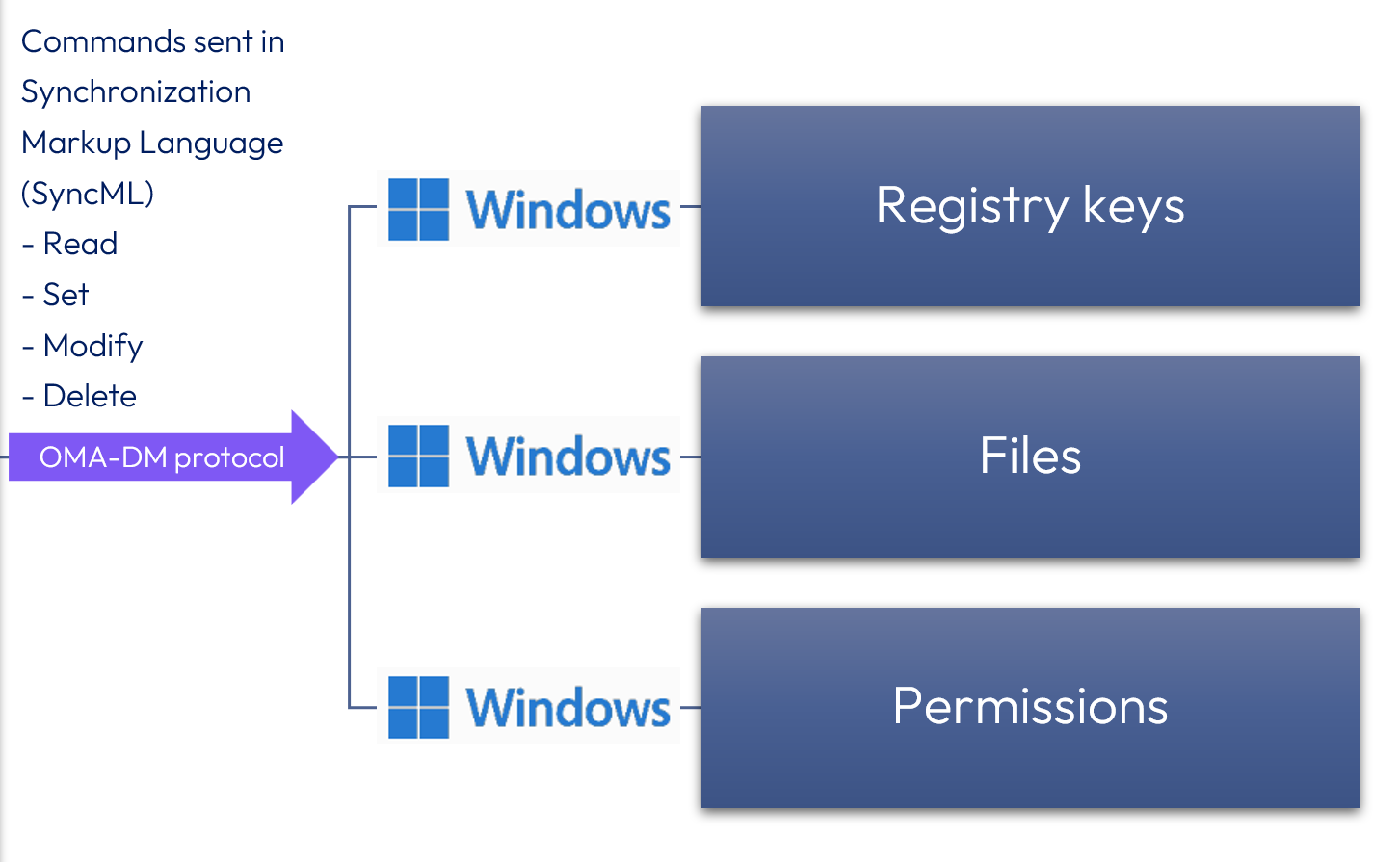
Figure 2: The role of SyncML and OMA-DM in Windows device management
OMA-DM/WNS and Intelligent Hub/AWCM comparison
There are some key similarities and differences between OMA-DM/WNS and Intelligent Hub/AWCM:
| OMA-DM | Intelligent Hub | |
| Description | Native MDM client built into the Windows device | Workspace ONE Intelligent Hub client software installed on the device |
| Owner | Microsoft | Omnissa |
| Type | Open standard | Proprietary |
| Communication | Windows Notification Services (WNS) | AirWatch Cloud Messaging (AWCM) |
| Device type |
|
|
| Uses |
|
|
| Security |
|
|
| Troubleshooting log |
|
|
| Host name and port(s) |
|
|
Figure 3: OMA-DM and AWCM comparison
The Troubleshooting section delves into validating OMA-DM/WNS and Intelligent Hub/AWCM functionality.
Communications
Communication flows depend on both the functionality being used and the settings configured in the Workspace ONE UEM console. Many settings, such as Software Deployment (SFD), Baselines, and BitLocker configuration are solely controlled via Intelligent Hub, whereas provisioning Windows Desktops via Out-of-Box Experience (OOBE) and Autopilot uniquely rely on OMA-DM.
Note that these communications occur via Configuration Service Providers (CSPs), which are specialized APIs that translate instructions into specific actions or settings on the Windows device.
Workspace ONE Windows Desktop Profiles can be managed through one or both of the following methods:
- ADMX Windows Profiles, which exclusively utilize Intelligent Hub
- Windows Profiles, which largely utilize OMA-DM and Microsoft CSP commands that are discussed at length within the Workspace ONE UEM Windows Baselines and Profiles article on TechZone
- Note: not all legacy Windows Profiles rely on OMA-DM. For example, the BitLocker legacy payload is managed by Intelligent Hub, as shown below:
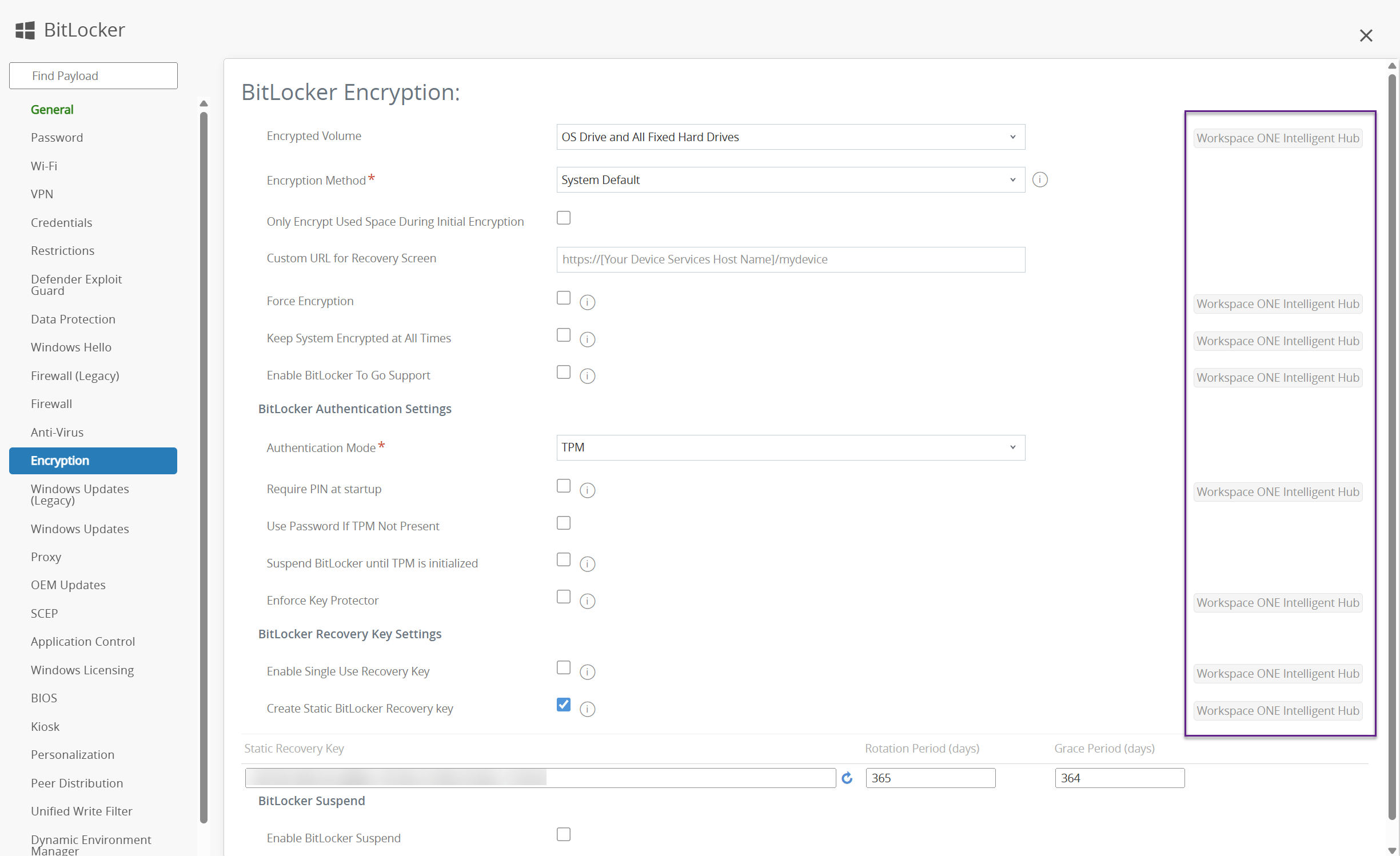
Figure 4: A legacy Windows Profile payload that utilizes Intelligent Hub
While it is likely that both Legacy and ADMX Windows Profiles are in use within your environment, consider transitioning to ADMX Profiles to minimize dependency on Microsoft CSPs.
OMA-DM is not embedded into Windows Server and thus communications occur entirely via Intelligent Hub/AWCM. This means that all functionality dependent on OMA-DM, including most Legacy Windows Profile payloads, as well as provisioning via OOBE and Autopilot, are not possible for Windows Server devices. Consequently, ADMX Profiles are the only Profile option for Windows Server.
Legacy solution stack
Where legacy Windows Profiles are configured for settings such as Windows Updates, firewall, and WiFi, Microsoft CSPs are used for management of Windows Desktops via OMA-DM.
This process is depicted below:
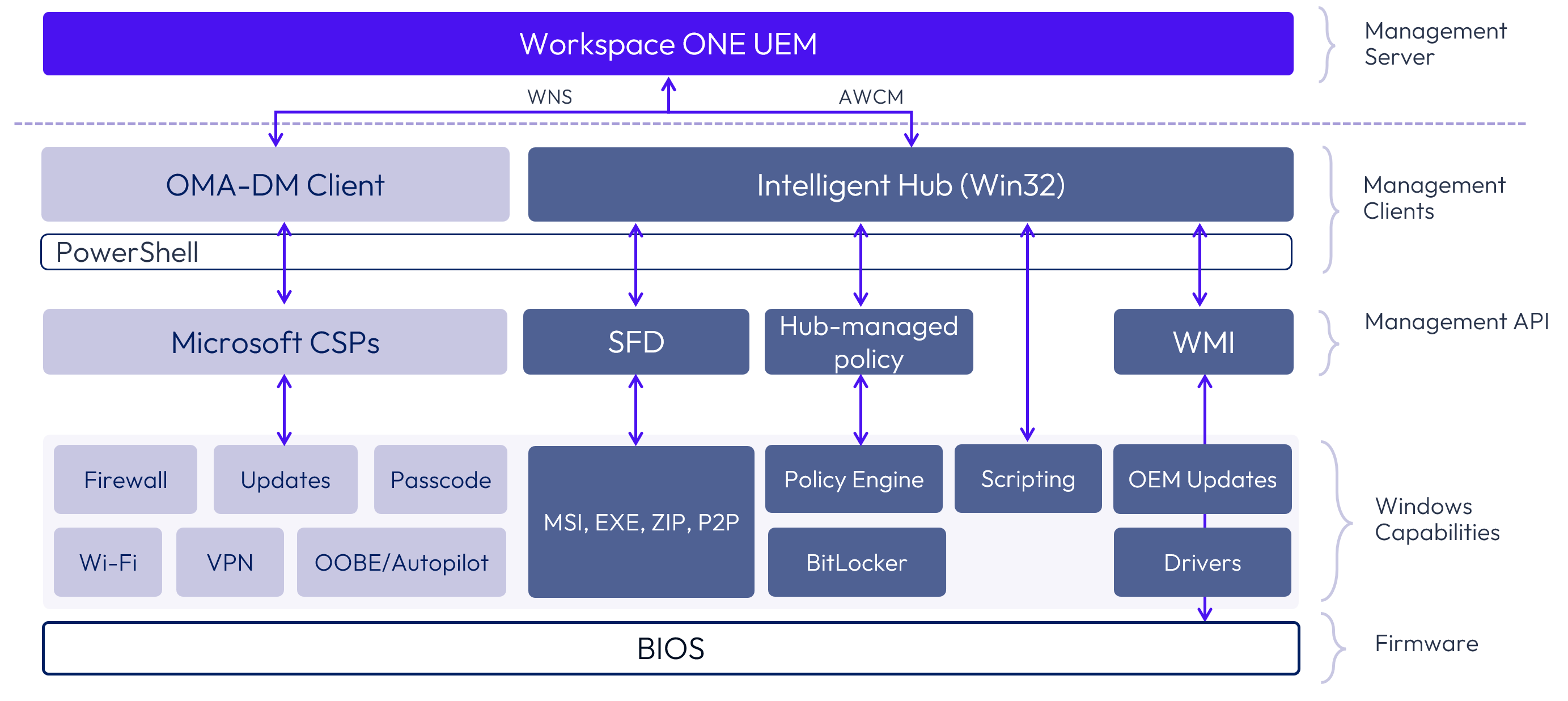
Figure 5: Management of Windows Desktop devices via both Intelligent Hub and OMA-DM
Note that SFD signifies Software Deployment, the built-in Intelligent Hub mechanism for application deployment.
New solution stack
In addition to a greater number of policy options, ADMX Profiles solely communicate via Intelligent Hub and have zero dependencies on OMA-DM. While ADMX Profiles are optional for Windows Desktop devices, this is the only Workspace ONE Profile option for Windows Server devices.
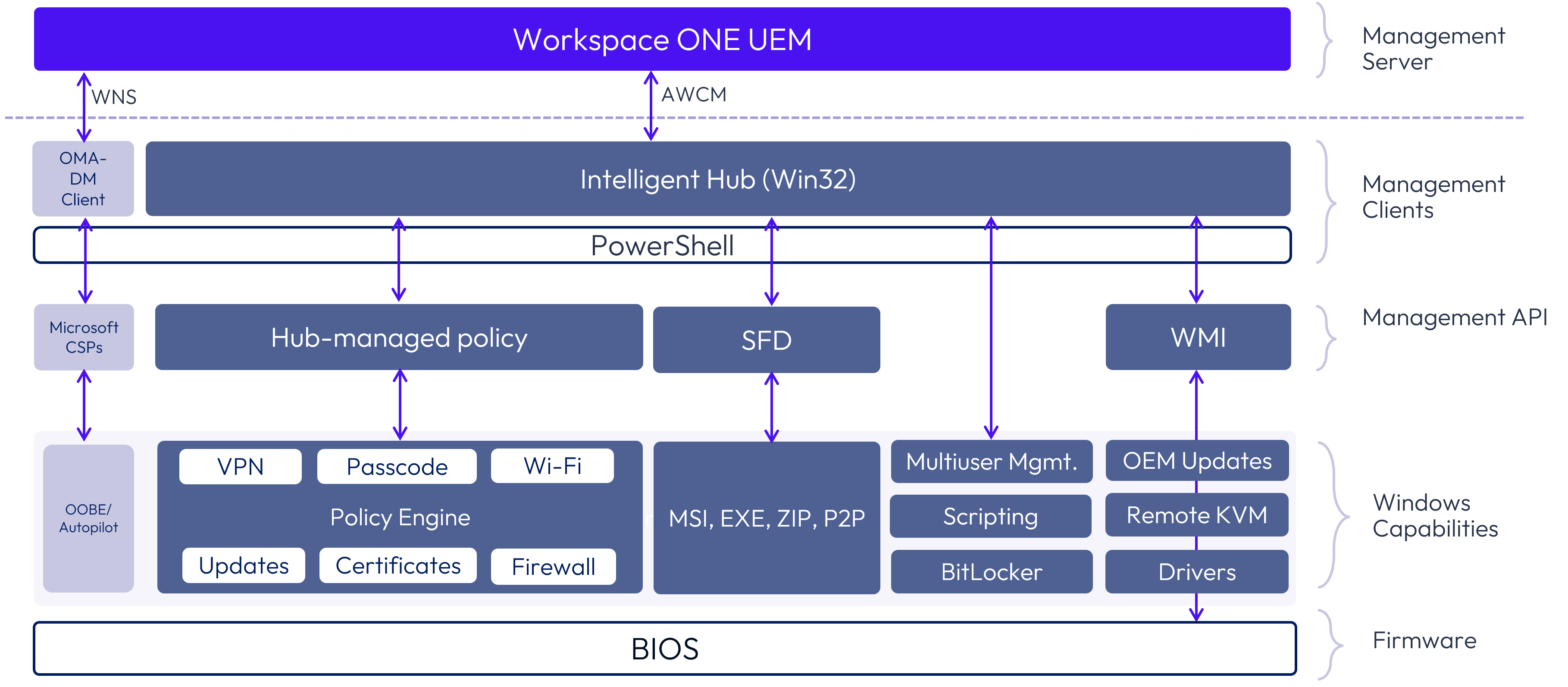
Figure 6: Management of Windows Desktop and Windows Server devices via Intelligent Hub-controlled settings
Ports
Workspace ONE components communicate over numerous ports, and blocked ports may cause communication failures. All external communications require TCP port 443 for secured traversal over the internet. For a complete list of the ports and protocols required, please see:
- For Workspace ONE: https://ports.omnissa.com/home/Workspace-ONE-UEM
- For Microsoft-related network requirements, https://learn.microsoft.com/en-us/windows/privacy/manage-windows-11-endpoints
Additionally, a third-party utility, the Intelligent Hub for Windows Troubleshooting tool, also known as HUBWTT, includes TestNet (test network) functionality to validate the required network ports from a Windows device.
Desired State Management
Desired State Management (DSM) ensures that devices synchronize to ensure adherence to organizational policies and requirements. By continuously assessing and enforcing the desired applications, and policies, consistency and compliance is ensured across the device fleet. This involves evaluating each device's current state against the desired state defined by the organization and taking corrective actions to bring devices into compliance if they deviate from the desired configuration. This helps enhance security, streamline operations, and improves the overall efficiency of device management.
Please see the Resource Delivery and Optimization article in Omnissa TechZone for more details.
Windows settings
When troubleshooting Windows issues, settings that impact all Windows devices within your environment should be evaluated. These settings can be found within Groups & Settings > All Settings > Settings > Devices & Users > Microsoft > Windows and control various behaviors of the Windows devices in relation to Workspace ONE.
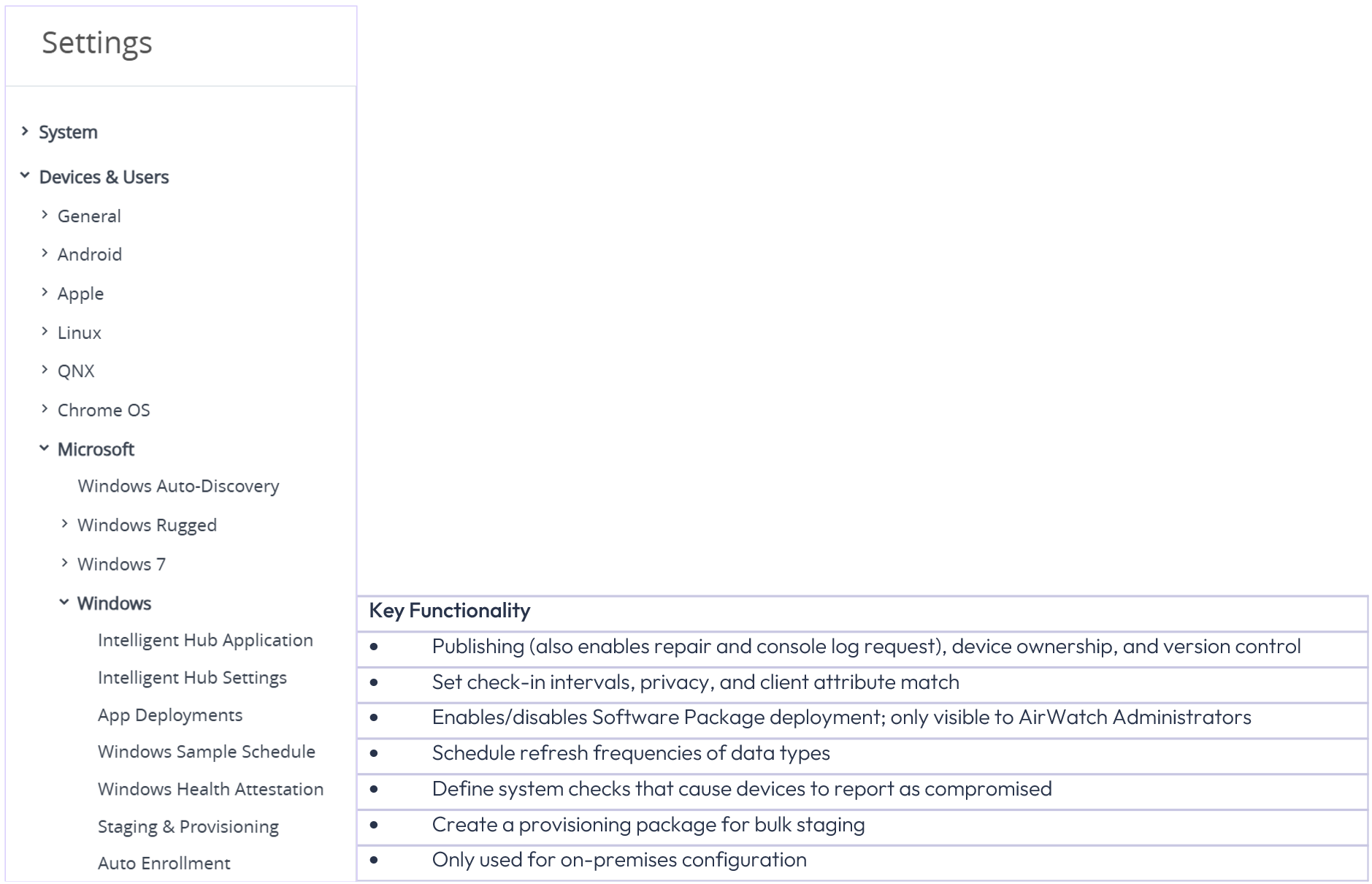 Figure 7: Windows device settings
Figure 7: Windows device settings
The table below shows the individual Windows tabs and how these settings may affect troubleshooting general Windows issues.
| Tab name and Docs link | Key settings | Troubleshooting considerations |
| Intelligent Hub application | Publish Workspace ONE Intelligent Hub | Also enables Repair Hub and Request Device Log functionality within Administrative Console actions |
| Intelligent Hub version control | Determines which version of Intelligent Hub is propagated to devices | |
| Intelligent Hub settings | MDM Channel Security | All traffic inherently traverses securely via HTTPS; setting has no impact and will be deprecated in the future |
| Privacy > Collect Analytics | Enables crash reports collection | |
| Attributes for Unique Identifier > UEM & Client | For AD domain joined devices, determines match for Multiuser functionality; recommendation is UPN/UPN | |
| App Deployments | Software Package Deployment | If disabled, apps cannot be deployed Note: Starting with v2506, SFD is coupled with Intelligent Hub and no longer dependent on OMA-DM |
| Windows Sample Schedule | All | Defines sampling frequency for device details, security, applications, certificates, Windows Server features, and other data points |
| Windows Health Attestation | Compromised Status Definition | All items not checked will not trigger compromised status for administrators; recommendation is to review all items and enable as appropriate to ensure administrative notification |
| Staging & Provisioning | Online Drop Ship Cache Server URL | Validate URL when experiencing provisioning issues |
| Auto Enrollment | Auto Enrollment | Only used for on-premises and no impact on SaaS |
Figure 8: Individual tabs under Windows settings
Non-Workspace ONE configurations and processes that may impact Windows devices
Configurations and processes can impact Windows devices—sometimes without the Workspace ONE administrator knowing they exist.
GPO conflicts
If your enterprise has Active Directory GPO(s) that set policies, these may cause unexpected device behavior or intermittent issues and cause seemingly countless administrative hours. Omnissa recommends that GPOs should not be applied to Windows devices.

Figure 9: Same setting configured in both GPO and Workspace ONE Baseline will create conflicts and seemingly intermittent issues
Scripts
Similar to GPOs, scripts may modify registry keys, Windows Services, Task Scheduler, or perform other actions. While Workspace ONE does provide scripting functionality and Freestyle Orchestrator, Active Directory and other tools may push out Powershell and other scripts.
For example, if a GPO or third-party tool invokes a script that enables a USB device type and a customized Baseline prohibits that same device type, a conflict will occur.
Agents/clients
Some agents/clients installed on Windows devices can prevent Workspace ONE from functioning properly. Examples include:
- Existing device management client, such as Microsoft Intune
- Security clients and firewall configurations that disallow Workspace ONE communications
Logging, including Event Logs, Service Logs, and Syslog
Event Logs
Windows device event logs provide a plethora of useful details regarding endpoint communication and processes. Below is a list of key event logs; however, other event logs may likewise be useful.
All event logs listed below are accessed from the local device and should be prefaced with:
- Event Viewer (Local) > Applications and Services
| Functionality | Description | Event Viewer Log |
| OMA-DM communications | Collects every interaction between the device and Workspace ONE UEM | > Microsoft > Windows > DeviceManagement-Enterprise-Diagnostics-Provider > Admin |
| Enterprise Data Protection | Collects logs related to WIP and Audits | > Microsoft > Windows > EDP Audit Regular Channel > Microsoft > Windows > EDP Audit TCB Channel > Microsoft > Windows > EDP App Learning |
| AAD & User device registration | Collects all information related to Azure Active Directory (Entra ID) | > Microsoft > Windows > AAD > Operational section > Microsoft > Windows > User Device Registration > Admin section |
| BitLocker | Collects BitLocker information | > Microsoft > Windows > BitLocker-API > Microsoft > Windows > BitLocker-DrivePreparationTool |
| Drop ship online | Drop ship provisioning | > AirWatch-Provisioning Agent
|
| Certificates | Validate certificates | > Microsoft > Windows > CAPI2 (enable log and reproduce errors). > Microsoft > Windows > CertificateServicesClient-Lifecycle-* (System and User). > Microsoft > Windows > CertPolEng |
Figure 10: Useful Event Logs for troubleshooting
Intelligent Hub logs
Captured logs can provide detailed event tracking and be useful for pinpointing complex issues.
Logs can be captured from the device or console, and then analyzed or provided to Global Customer Services. Workspace ONE UEM Device-Side Logging in Omnissa docs provides detailed information on what logs are provided on each device type.
Logs can be captured remotely from the console by following the instructions within the Windows Desktop Devices (Windows HUB) section.
Core services
Detailed information is available at Core Services Logging section for all console side services, including how to capture and controlling log levels.
Syslog
Syslog can be configured for integration with your Security Information and Event Management (SIEM) tool, such as Splunk. Please see Omnissa Docs for information about functionality and configuration.
Administratively gather device logs
Rather than logging onto the client device remotely or making requests of the user, a variety of logs can be administratively captured from the Workspace ONE UEM console. After selecting the device in the console, click More Actions > Request Device Log to administratively request the desired logs.
Three types of logs can be requested based on all logs or the last 1, 3, 7, or 14 days:
- Hub, which provides Intelligent Hub details, as well as software distribution and provisioning
- System, which focuses on environmental details, including local Event Viewer logs and running processes based on applications and events
- Additional, which collects logs for all other applications on the device
After these logs have been captured, they are shown as a zip file within the console under More > Attachments > Documents and can be unzipped and explored.
Figure 11: Log files
Omnissa Docs provides a complete list of log files and information contained within it.
Validation and troubleshooting
In this section, validating the status of Windows devices and general troubleshooting will be discussed. For step-by-step details about troubleshooting and logging, please also see Omnissa Docs.
There are three key mechanisms that are useful for troubleshooting:

Detective Admin, are you ready to start searching for clues to resolve Windows device mysteries?
Workspace ONE console
Because numerous monitoring data points are displayed within the Workspace ONE admin console, this should be your starting point. Status information can be viewed, and actions can be taken directly from the console.
Device status
After selecting a specific device, view the numerous options to view status of the device. Click Devices > Devices and select a device, which will then be presented within the Details View screen.
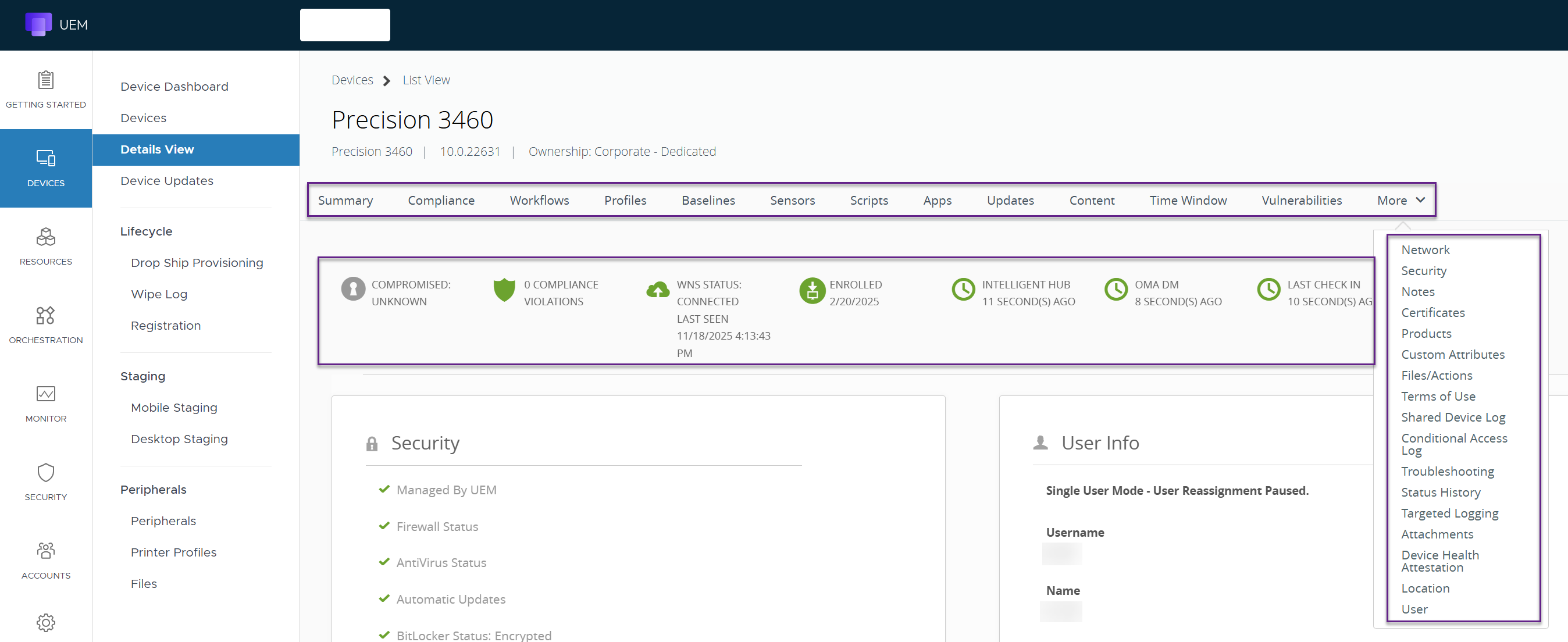
Figure 12: Device status provided within Workspace ONE UEM console Summary screen
The List View screen provides a holistic overview of the device, including WNS, Intelligent Hub, and OMA-DM status. The update interval is dependent upon the Intelligent Hub configuration within the universal Windows settings. Please note that there is a difference between the "Last Seen" and "Last Check In" fields shown above.
- Last check-in specifically tracks when Intelligent Hub last checked for pending commands, resources, and other updates
- Last seen captures when the device presence was last observed
In addition to the summary information presented, additional details may be particularly pertinent when researching issues.
Troubleshooting Tab
After viewing the basic device information, the Troubleshooting tab within the Devices screen will likely be your starting point. To access this tab, click More > Troubleshooting.
Event Log
The default view provides an administrative Event Log of all actions that have occurred on the device, including the date, time, administrator that made the change, and other details.

Figure 13: Troubleshooting Event Log
The event message is a hyperlink and may be clicked to provide additional information.
Commands
In addition, the commands that were executed on the device are presented within the second tab. The status of these commands, e.g., pending, queued, and removed, may be useful to understand changes on the device.
Figure 14: Queued and pending commands after clicking the Query button
Queued and pending commands should be executed quickly if the device is online.
Key Administrative Console Actions
Under the Actions buttons in the upper right corner, queries and management/administrative actions can be initiated. Several key troubleshooting actions are described below.

Figure 15: Query and key More Actions options useful when troubleshooting
Query
Queries are particularly useful in understanding the state of the device at that point in time. While it is possible to select individual queries, it is typically more expeditious to select the Query button to query all Intelligent Hub services and send that status to the console.
Depending on the selected option, the full set of queries or individual queries will be listed on the Troubleshooting > Commands screen as pending until they are executed. Once complete, the query results will be available within the respective status screens upon refresh, including the Troubleshooting Event Log and Commands screens.
Reboot Device
Some issues are resolved by simply rebooting the device. Administrators can force the Windows device to reboot within five minutes, allowing the user to wrap up active work.
Request Device Log
This selection allows event logs from the Windows device to be gathered administratively without user effort. Note that this option is only available if Publish Intelligent Hub is enabled within Groups & Settings > All Settings > Settings > Devices & Users > Microsoft > Windows > Intelligent Hub Application, provided that the device has an active user session.
Repair Hub
Clicking Repair Hub administratively enables the ability to re-establish communication between a Windows device and the Workspace ONE Intelligent Hub. This feature remediates communication problems like HMAC errors, failed Hub upgrades, reinstates any removed Hub files from the system, and restarts any Hub-related windows services. The RecoveryService.log provides information regarding the status of the Workspace ONE Intelligent Hub auto recovery functionality.
Intel vPro
Intel vPro actions enable administrators to remotely trigger any of the following:
- Power on
- Power off
- Power cycle
- Reset
- Remote keyboard, video, and mouse (KVM) control
These actions may be useful when troubleshooting. For details regarding Intel vPro, please see the Chip-to-cloud management with Intel vPro article on Omnissa TechZone.
Sensors
Sensors can be used to not only ascertain system resources, but also status of devices.

Figure 16: Using Sensors to determine device status
For example:
- Does the device have sufficient hard drive space?
- Is the device domain joined?
Intelligence
Workspace ONE provides a plethora of information within Intelligence that may be useful for troubleshooting. As an example, when troubleshooting an issue related to Windows Updates compliance, a Sensor could be deployed in conjunction with a dashboard or report to display the devices that are pending reboot and therefore have not completed their updates.
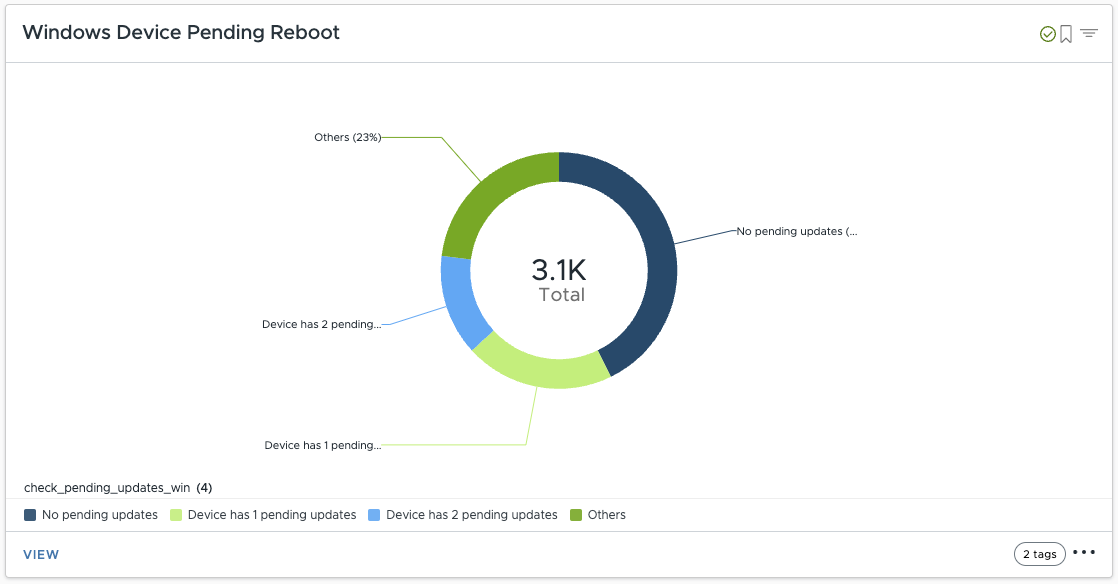
Figure 17: Intelligence reports showing Windows devices pending reboot
Likewise, a dashboard could be leveraged to display device memory utilization over time.
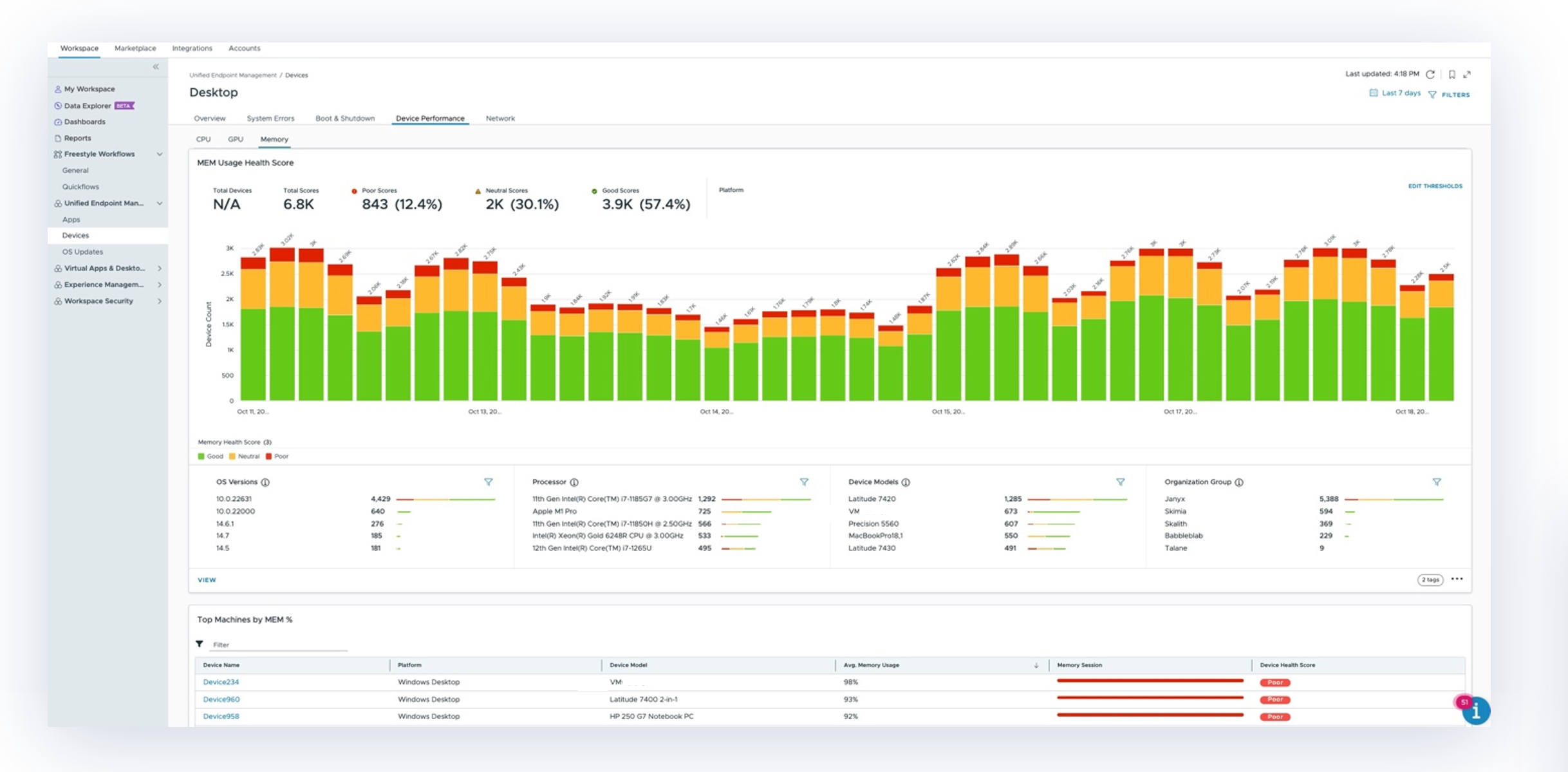
Figure 18: Intelligence dashboard displaying memory utilization
Similarly, the Guided Root Cause Analysis (RCA) feature could be utilized to help determine the cause of application crashes, post a Windows Update.
Up to 16 widgets can be incorporated in a single Dashboard to display multiple metrics at once.
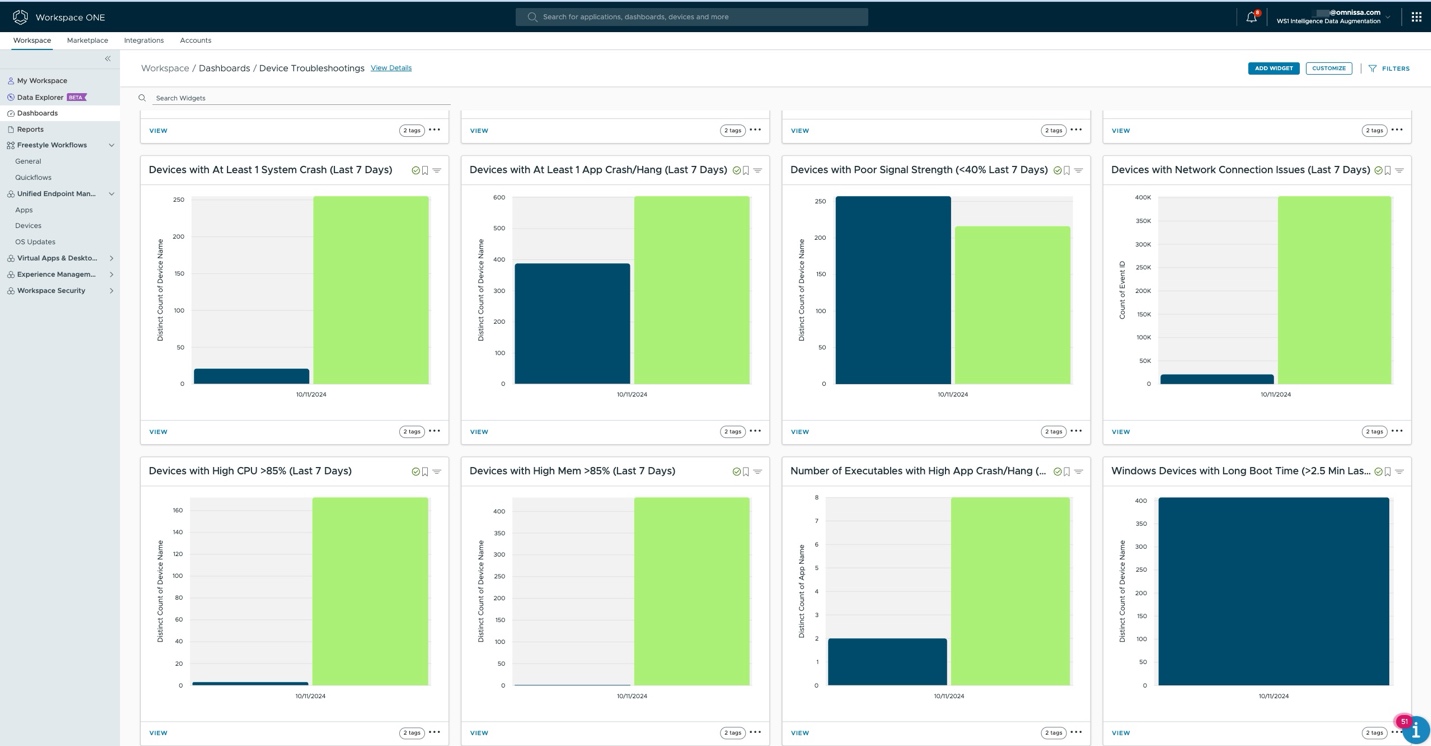
Figure 19: Customized Dashboard showing numerous metrics
Further, Experience Management provides built-in dashboards and reports to surface common problems such as long boot times.
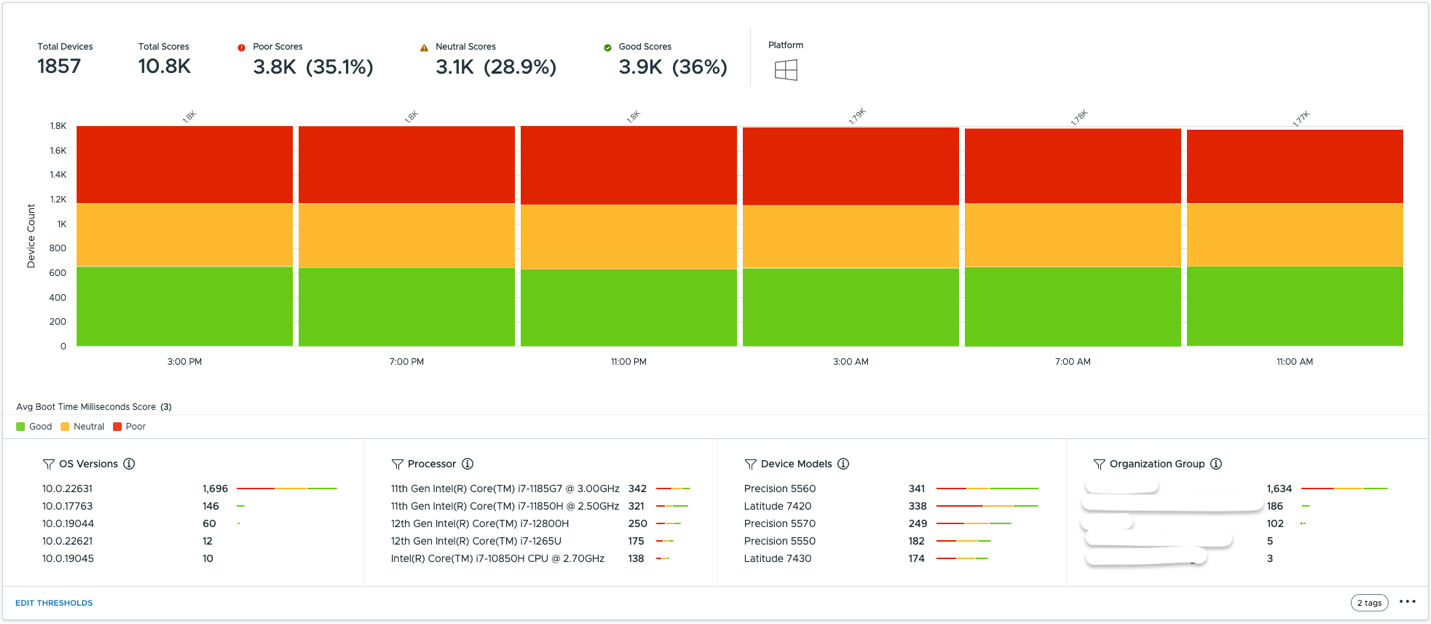
Figure 20: Common issues such as long boot times displayed within built-in Dashboard
Intelligence can use and display data points that Sensors and the DEEM agent collect, displayed in the appropriate format for that data type, and filtered for those devices with particular values, providing for quicker resolution.
Validating Intelligent Hub/AWCM and OMA-DM/WNS Functionality
AWCM is the communications lifeblood for both Windows Desktop and Windows Server devices, and WNS communication is likely used for your Windows Desktop devices. Thus, it is essential to ensure that both these communications are functioning properly. Both protocols traverse the network securely via HTTPS.
AWCM
AWCM to Workspace ONE UEM console communications can be verified from the Workspace ONE console. Go to Groups & Settings > All Settings > Settings > System > Advanced > Site URLs > AirWatch Cloud Messaging. Verify that the AWCM server is enabled, and then click Test Connection.

Figure 21: Validating AWCM connectivity
To validate Windows device to AWCM communications, two options are available:
- Research entries within the AwclClient.log, which will display AWCM communications failures
- Intelligent Hub for Windows Troubleshooting Tool (HUBWTT) TestNet
WNS
OMA-DM/WNS inherently communicates between Workspace ONE UEM and Windows devices securely via HTTPS.
The WNS status of a Windows device can be seen on the Devices page. Go to Devices > select the device and view the status within the Details View screen.

Figure 22: Validating WNS connectivity
User device
Intelligent Hub utilities
On the user device, Intelligent Hub provides some troubleshooting functionality directly on the Windows device.

Figure 23: Intelligent Hub options as shown from the taskbar
To troubleshoot on the local device, right-click the Workspace ONE Intelligent Hub icon in System Tray > Troubleshoot. Three options are presented:
- Send Logs to UEM, with options to send the Hub or Additional logs
- Collect Logs, wherein the user is prompted to select a local directory to save pertinent Event Viewer logs.
- Hub Status, which is used to perform a quick test and displays helpful information about the device and services running on the device. It will reveal the unique Device UDID, Windows and Intelligent Hub Services status, whether the device can reach the Workspace ONE Management Server, and other details.
These options are also presented within Intelligent Hub app when the user clicks their name in the lower left corner. In addition, forced synchronization (Sync) can be initiated from the endpoint.
Event Viewer logs can provide valuable clues; however, please be aware these and other logs can be pulled administratively through the Workspace ONE Request Device Log functionality.
These logs are cumulatively stored within the following directory on the Windows endpoint device:
- C:\ProgramData\AirWatch\UnifiedAgent\Logs
Omnissa Docs provides a complete list of log files and information contained within each file.
Below is an example of Hub Status output:
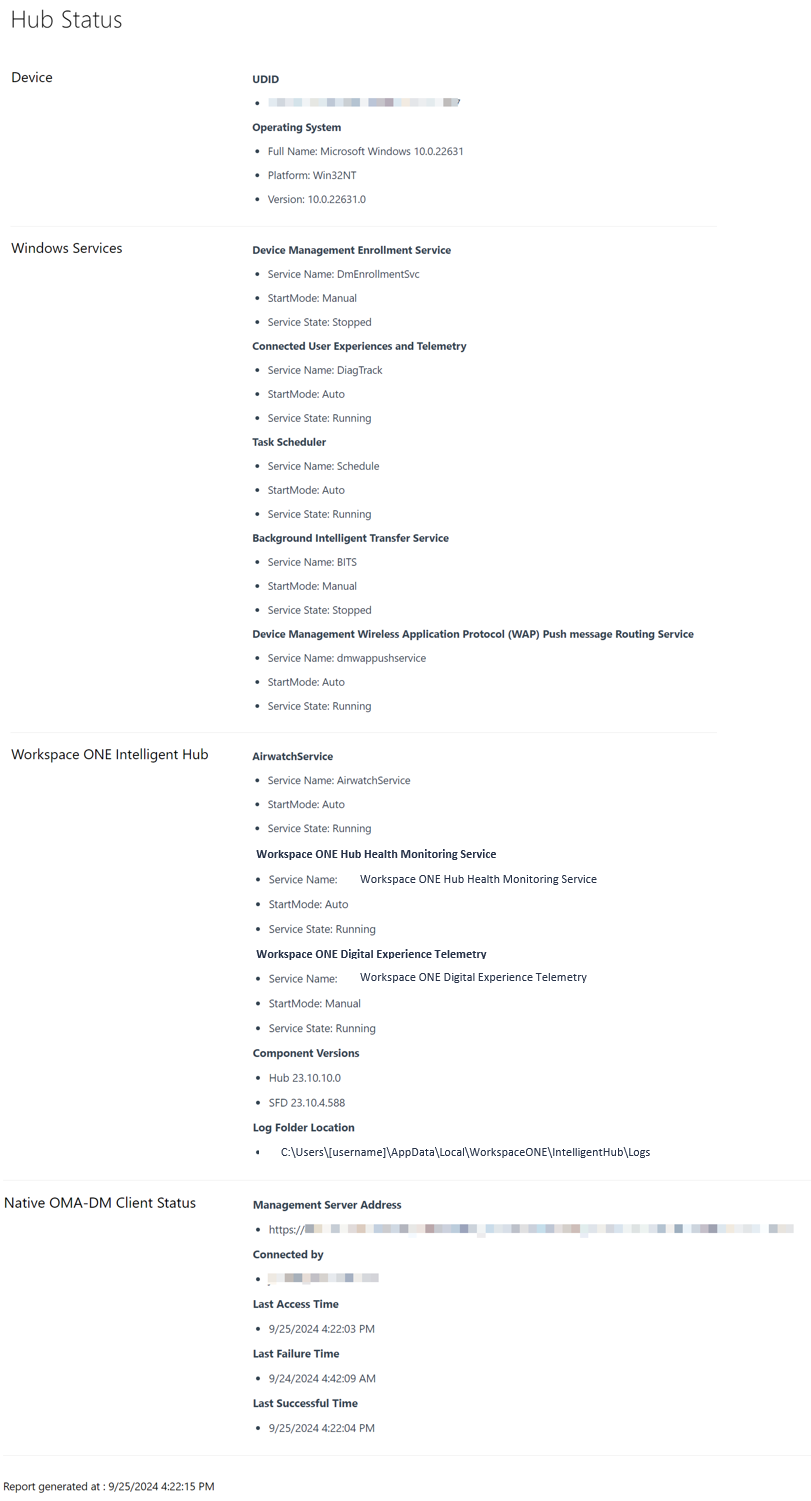
Figure 24: Hub Status report displayed on the Windows client device
Note that the status of Windows Services and Workspace ONE Intelligent Hub are reported. The state of these Windows Services depends on the functionality that you have enabled, such as device enrollment and software distribution.
Alternatively, an administrator may remotely access the local device using Workspace ONE Assist or request that the user collect specific data.
Workspace ONE Configurations Applied to Windows Device
On the Windows device, Workspace ONE settings can be ascertained via Settings > Accounts > Access work or school > Connected > Managed by Workspace ONE > Info.
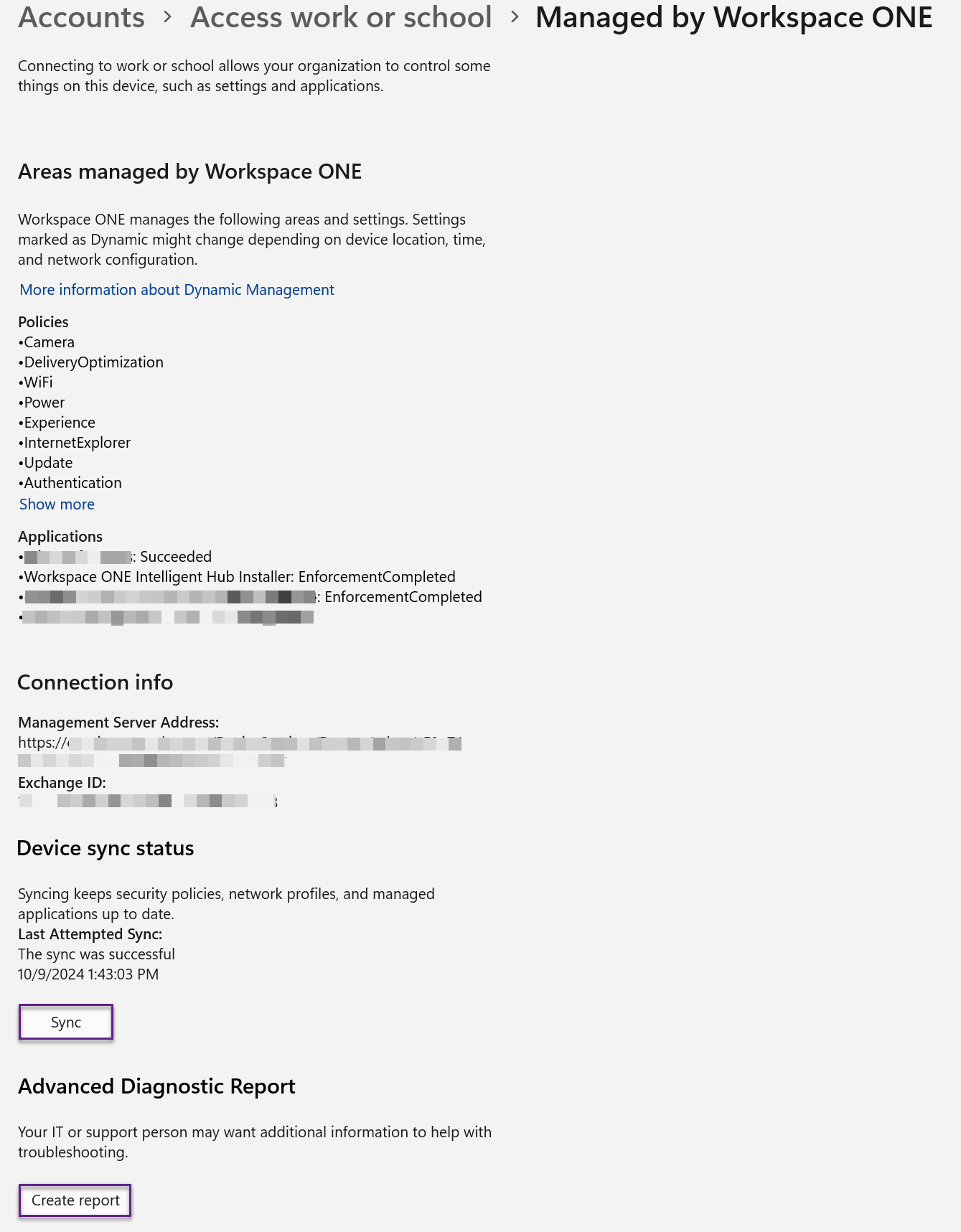
Figure 25: Workspace ONE status information on the Windows device
In addition to the valuable status information presented, two key actions can be taken from this screen:
- Sync, which forces synchronization with Workspace ONE UEM
- Create report, which creates a detailed report entitled MDMDiagReport that shows all settings and policies (both Workspace ONE and GPOs) applied to this device:
- Device info
- Connection Info
- Device management account
- Certificates
- Enrolled configuration sources and target sources
- Managed policies
- Managed applications
- Wi-Fi profiles
- GPCSEWrapper policies
- Blocked group policies
- Unmanaged policies
For example, if Workspace ONE Baselines or Profiles are not applying correctly, the MDMDiagReport details exactly which policy settings are applied from which source. Keep in mind that this information is not static and is affected by the reapplication of policies.
Third-party utilities
Please note that the third-party utilities referenced below are downloaded, installed, and used at your own risk, and Omnissa takes no responsibility for the use of these tools. Please follow your enterprise requirements regarding the installation and use of third-party utilities.
Fiddler Everywhere
A free 10-day trial of Fiddler Everywhere is available from Telerik. This tool enables administrators to view and analyze network traffic between the client device and Workspace ONE, including OMA-DM and Intelligent Hub traffic.
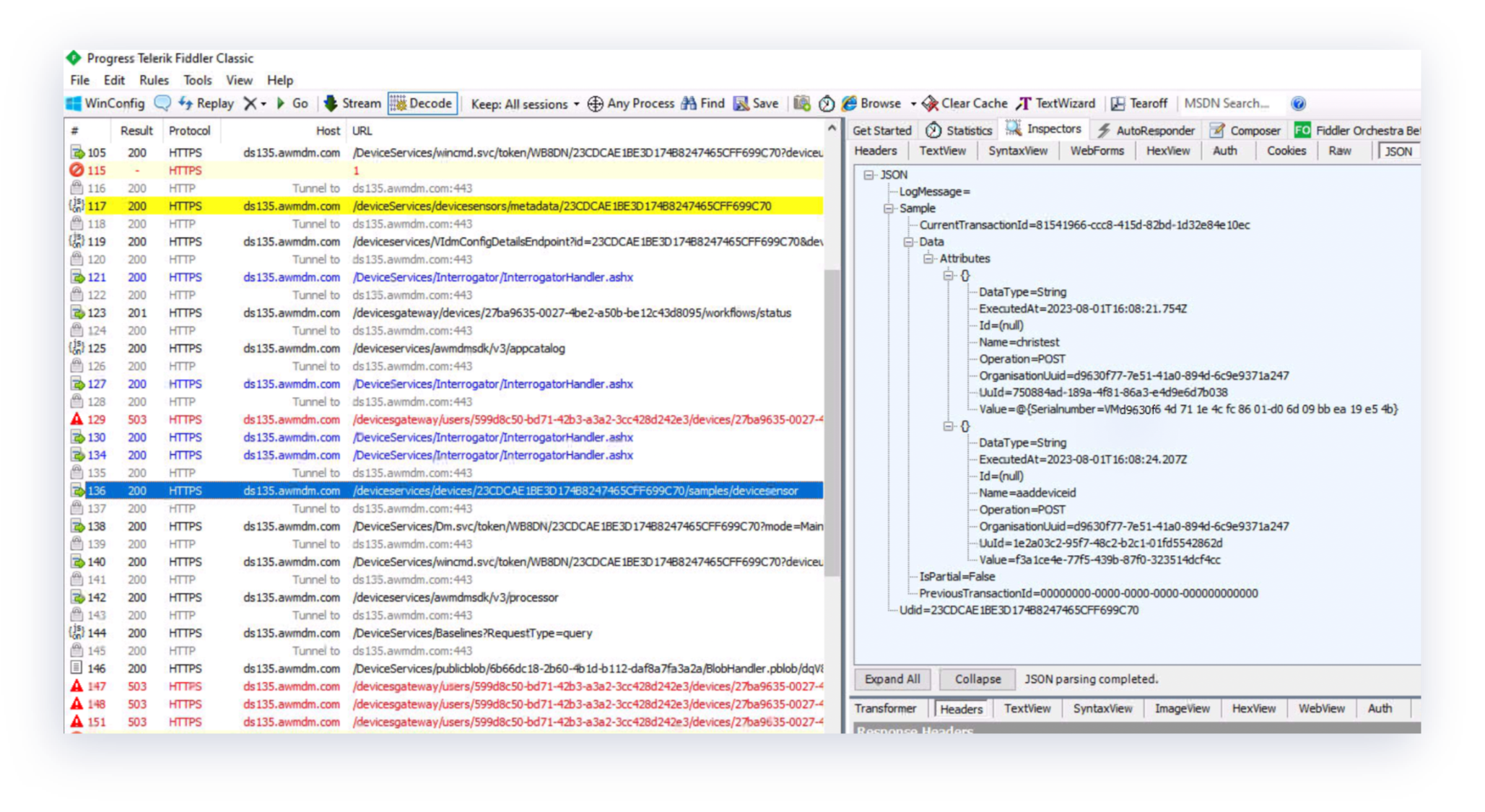
Figure 26: Fiddler output
SyncML Viewer
SyncML Viewer is a free tool that is useful for assessing OMA-DM traffic and is available from GitHub. By viewing the SyncML protocol traffic between the Windows client and Workspace ONE, endpoint device activity can be monitored in real time via event tracing for Windows (ETW). After capturing OMA-DM traffic, it can be parsed, analyzed, or exported as a .txt file.
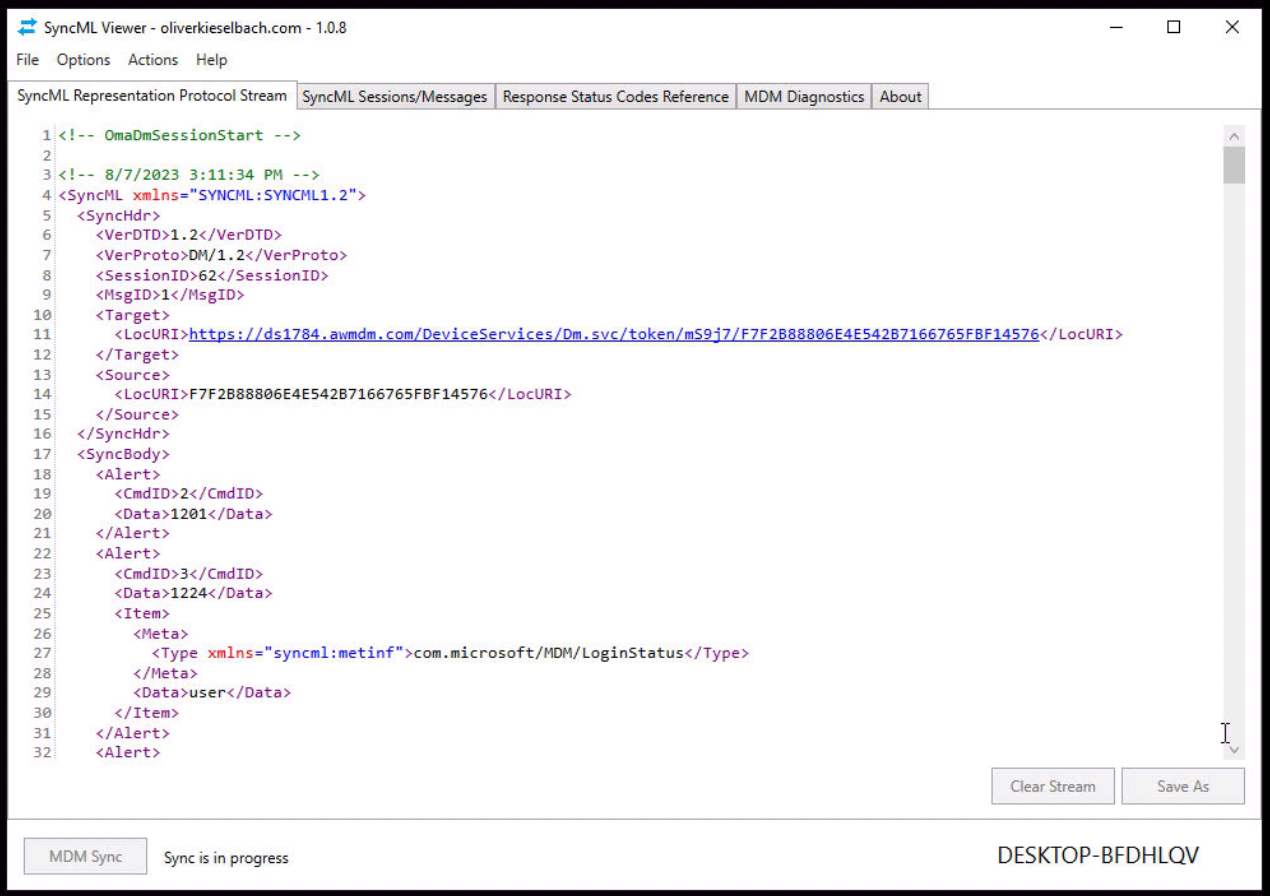
Figure 27: SyncML Viewer output
Intelligent Hub for Windows Troubleshooting Tool (HUBWTT)
The Intelligent Hub for Windows Troubleshooting Tool (HUBWTT.exe) is available within GitHub. It is a command line app that can be used to display Workspace ONE Hub for Windows (HUBW) configuration settings, as well as perform some functions to help with supporting HUBW:
- Managed Applications Info
- Baselines Info
- Export HUBW LiteDB
- General (HUBW), Sample and Custom Lookup info
- LAPS Function
- Logs Functions
- Profiles Info
- Scripts Info
- Sensors Info
- Test Network Function
- Workflows Info
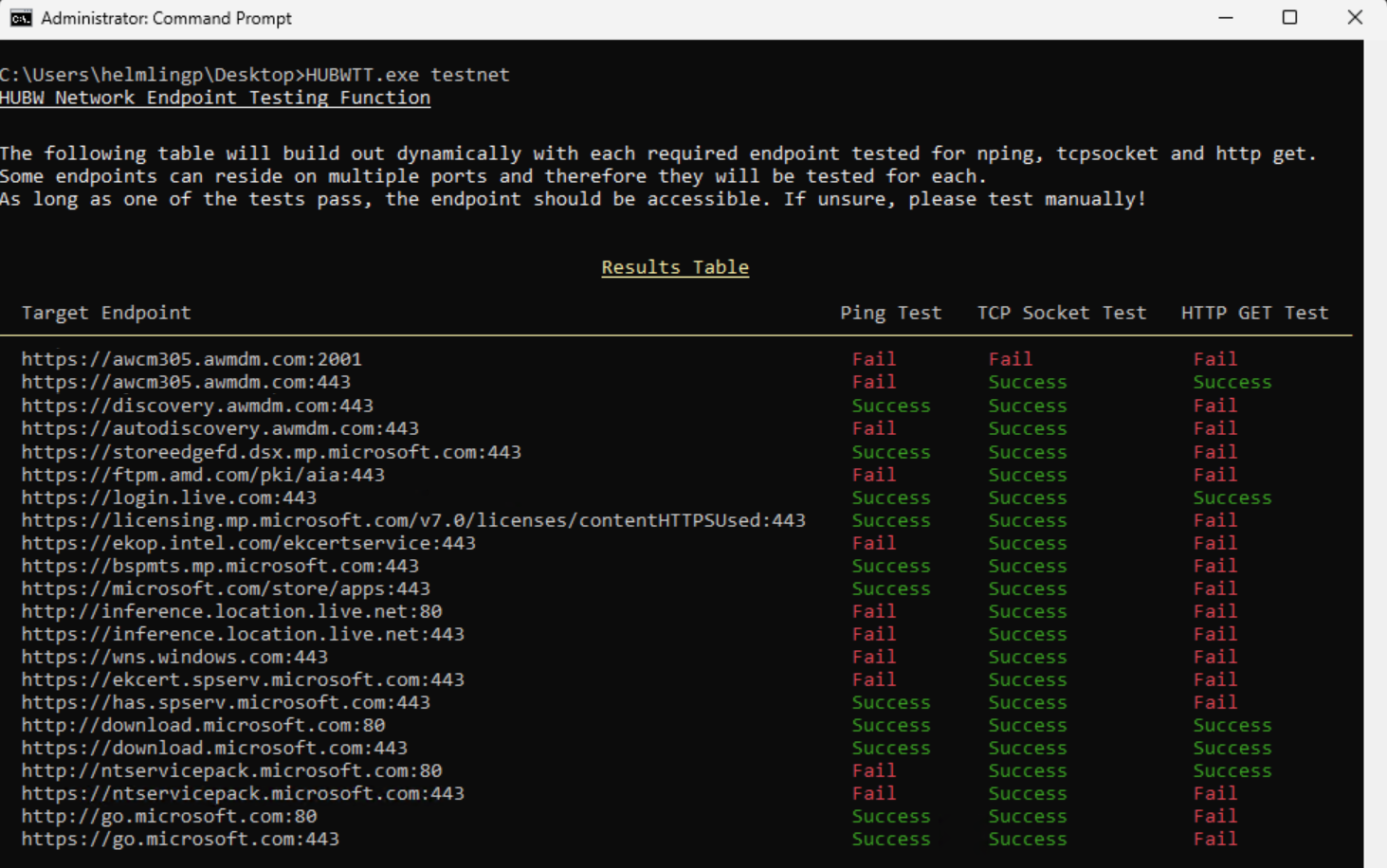
Figure 28: HUBWTT TestNet functionality
SysInternals: ProcMon and PSExec
Lastly, two common SysInternals tools can provide extensive details to research complex issues:
- Process Monitor (ProcMon) provides detailed file system, registry, and process activity.
- PSExec is a telnet-like tool that enables command prompt access.
Common Windows device issues and resolution checks
Based on input from Omnissa Customer Success and Technical Support, the most common Windows device issues and resolutions are:
| Issue | Resolution Checks |
| Windows Baselines and Profiles not applying properly |
|
| Apps not installing |
|
| Antivirus false positives |
|
| Multiuser functionality |
|
| User on multiuser device is prompted to enter Organization Group ID |
|
| BitLocker encryption |
|
| Device log capture cannot be initiated from console |
|
Figure 29: Common Windows device issues
Additional Windows device resources
Troubleshooting more specific Windows functionality issues may require more additional information than is provided in this guide.
In addition to deep technical functionality explanations, these Omnissa TechZone guides provide troubleshooting information and steps:
- Configuring Windows Baselines and Profiles
- Deploying Workspace ONE UEM applications to Windows devices
- Managing Updates for Windows devices
- Provisioning, Enrolling, and Onboarding Windows devices
- Workspace ONE UEM Windows Multiuser
Changelog
The following updates were made to this guide:
| Date | Description of Changes |
| December 2025 | Updates including Windows Server, expanded Intelligent Hub functionality, screen shots and other changes |
| March 2025 | Minor updates, including screen capture refreshes. |
| October 2024 | Complete document rewrite. |
About the author and contributors
The latest version was written by:
- Jo Harder, Senior Technical Marketing Architect, Omnissa
Contributors and reviewers:
- Ben Jacoby, Senior Enterprise Design Architect, Omnissa
- Chris Halstead, Adoption Product Manager, Omnissa
- Phil Helmling, Lighthouse Architect, Omnissa
- George Gritten, Adoption Product Manager, Omnissa
- Saurabh Jhunjhunwala, Lighthouse Architect
- Pooja Chengappa, Director of Product Management
Feedback
Your feedback is valuable. To comment on this paper, contact Omnissa via tech_content_feedback@omnissa.com.


